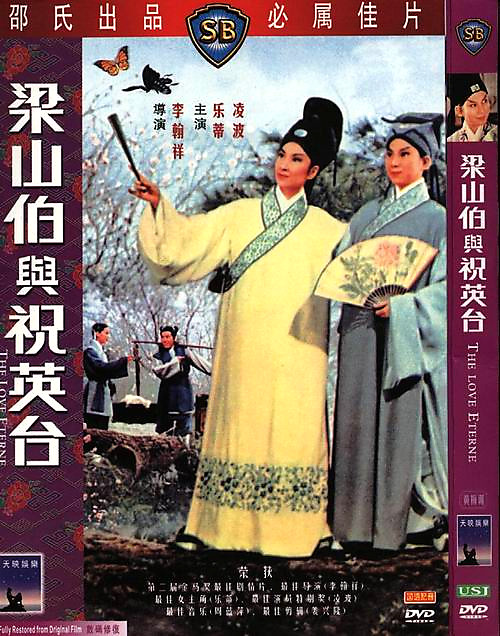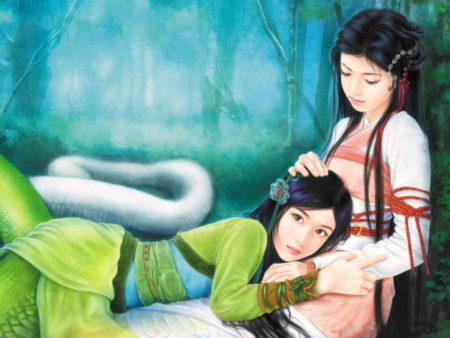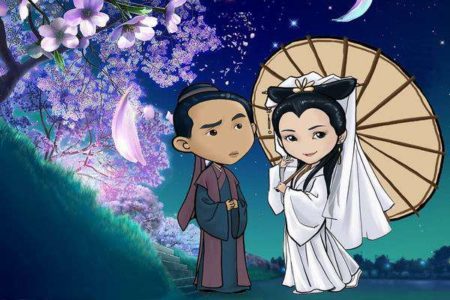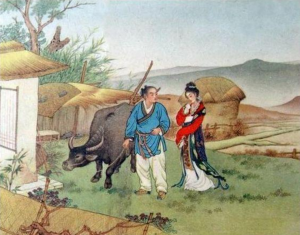
What are the 4 great Chinese folktales? Check it out!
Chinese Myths You Must Know
As mentioned in previous article Famous Chinese Myths You Must Know (Part 1), some of the Chinese myths have a comparative “Western version,” how the universe and men were created, scary fairy tales, and love stories. In part 2, you will know the famous and classic Chinese folktales that together, they are called “China’s Four Great Folktales.”
In a nutshell, the four great folktales of China are Liang Shanbo and Zhu Yingtai, Tale of the White Snake, Lady Meng Jiang, and The Cowherd and the Weaving Girl (Niu Lang and Zhi Nu). Without further ado, let’s hear the stories!
In English, there’s “Romeo and Juliet”; in Chinese, there’s…
Chinese Myths Butterfly Lovers: Liang Shanbo and Zhu Yingtai (梁山伯与祝英台, Liángshān bó yǔ zhù yīng tái)

Liang Shanbo & Zhu Yingtai film – modern version.
The love story is set in the Eastern Jin Dynasty when in the society only males can receive the education. Zhu Yingtai, as a girl, she persuades her father to let her study to Hangzhou in disguise of a boy. In her school days, she meets Liang Shanbo, a Shouxing scholar. Two of them becomes good friends as they study together for three years. Zhu Yingtai gradually falls in love with Liang Shanbo; however, Liang doesn’t know that Zhu is actually a girl.
After they finish their study and return to their hometowns, Liang Shanbo finally knows that his best friend is a girl when he visits her to her hometown. The two of them confessed their affection to each other and promise each other that “till death do us part”. Liang Shanbo would like to propose marriage to her, but it’s too late. Zhu Yingtai’s parents have already arranged her marriage to Ma WenCai, a son from a rich family.
Liang Shanbo later dies of depression when he’s working for the official. On the day Zhu Yingtai is going to married to Ma WenCai, she sits in the litter vehicle on the way to the groom’s house and there’s suddenly strong wind prevent the wedding journey when they are approaching Liang Shanbo’s grave. Zhu Yingtai leaves the wedding procession and pays her mourn in front of Liang’s grave. Suddenly, the grave opens up and the sad Zhu Yingtai jump into the grave…
To everyone’s surprise, soon after Zhu Yingtai throws herself in Liang Shanbo’s grave, a pair of butterflies fly out of the grave and fly away.
The tale of Liang Shanbo and Zhu Yingtai has many adaptation on stage plays, television programs, films, and exhibitions. It’s even applied for the Masterpieces of the Oral and Intangible Heritage of Humanity in UNESCO in 2004.

Liang Shanbo & Zhu Yingtai film – older version.
If you find out your wife is actually a snake…
Tale of the White Snake (白蛇传, Báishé chuán)
The Tortoise, the White Snake, and the little boy
The story is actually one of the tales of Chinese Dragon Boat Festival, beginning with one of the Eight Immortals (八仙, Bāxiān) Lu Dong-bin (吕洞宾, Lǚdòngbīn), who disguises himself as an ordinary man selling tangyuan (汤圆, Tāngyuán) made of immortality pills. A kid named Xu Xian (许仙, Xǔxiān) buys some from Lu Dong-bin, but the boy doesn’t know they are actually elixir. Xu Xian comes to Lu Dong-bin three days later because Xu Xian hasn’t been hungry for three days after he ate the tangyuan. Lu Dong-bin then helps Xu Xian to vomit the tangyuan into the lake nearby.
At this time in the lake, there are a white snake spirit and a tortoise spirit, both of whom have been practicing magical powers for centuries in order to transform into human shape and become immortal. The tortoise tries to eat the elixir tangyuan that Xu Xian just threw up, but the white snake gets it first, and thus the white snake gains 500-year magical powers. The white snake feels grateful for Xu Xian; however, the tortoise is angry and jealous of the white snake since then. Not able to become immortal, the tortoise dies with hatred and later reincarnate into a monk Fahai (法海, Fǎ hǎi), who still remembers to take revenge on the white snake.
Sisterhood Between the White Snake and the Green Snake

The white snake (Bai Suzhen) & the green snake (Xiaoqing)
One day, the white snake (白蛇, Báishé) in human shape, who is a beautiful lady, saves a green snake (青蛇, Qīng shé) from a human who is going to kill the green snake. The green snake can turn into human shape like the white snake does; to thank her, the green snake decides to stay with the white snake and regards her as an elder sister. The white and green snake then names themselves Bai Suzhen (白素贞, Báisùzhēn) and Xiaoqing (小青, Xiǎo qīng) respectively, when they are in human shape.
Eighteen years later…

Bai Suzhen and Xu Xian’s destiny has been intertwined since childhood.
Bai Suzhen meets the grown-up Xu Xian eighteen years later and marries him to pay her gratitude. The couple run their business and have a happy life. However, the revengeful Fahai is planning to break up the relationship of the couple, so he comes to Xu Xian and tells him to make his wife drink realgar wine (雄黄酒, Xiónghuángji) during Dragon Boat Festival. (Chinese people believe that the realgar wine can repel snakes or other venomous animals.) Bai Suzhen thinks that the wine cannot hurt her because she’s already immortal; however, she feels so sick after drinking the wine that forces her to reveal her true form as a huge white snake. Xu Xian is shocked to death after he found out his wife is a snake.
No, Not the End Yet

Fahai fight with Bai Suzhen.
Bai Suzhen is depressed toward Xu Xian’s death so she steals the medicine from Fahai to bring her husband alive. Xu Xian is still in love with Bai Suzhen even though she’s not a real human. Fahai is not giving up on separating the couple; he kidnaps and imprisons Xu Xian in Jinshan Temple (金山寺, Jīnshānsì). To rescue her beloved husband, Bai Suzhen brings her sister Xiaoqing to fight Fahai together. However, Bai Suzhen fails to save Xu Xian; her power is weaker because she’s pregnant. Xu Xian manages to escape and meet his wife for she’s giving birth to their son Xu Mengjiao. Fahai then captures and imprisons Bai Suzhen under Leifeng Pagoda (雷峰塔) until 20 years later, Xiaoqing becomes stronger in magical powers and defeats Fahai. The family finally reunites.
Extra fun: Interesting Sayings From this Chinese Folktale
As Fahai fails in the end of the tales, there’s an interesting saying that Fahai in his monk kayasa escapes and hides in the huge crab abdomen. That’s why the crab has the crab butter in yellow, the color similar to the monk clothes. Like other Chinese folktales, “The Tales of the White Snake” is adapted into TV shows and films in different versions. Here’s the 2011 action fiction movie The Sorcerer and the White Snake (法海:白蛇传说, Fǎ hǎi: Báishé chuánshuō).
You thought the Great Wall is soild? Really?
Lady Meng Jiang Wailed over the Great Wall (孟姜女哭长城 Mèngjiāngnǚ kū chángchéng)

Lady Meng Jiang Wailed over the Great Wall
During Qin Dynasty there’s a newly-wed couple Lady Meng Jiang (孟姜女, Mèngjiāngnǚ) and her husband Fan Xiliang (范喜良, Fàn xǐliáng). It’s the time the Chinese people were under the ruling of Qin Shi Huang (秦始皇), the first Emperor in China history. Shortly after the couple got married, Qin Shi Huang ordered labor recruitments to build the Great Wall of China. Fan Xiliang was forced into service to build the Great Wall, too.
Lady Meng Jiang didn’t hear from her husband in a while and felt worried about him. Therefore, Lady Meng Jiang packed some warm clothes and head off to the Great Wall on foot. When she finally arrived there, however, somebody told her that her husband died from exhaustion and unacclimatized.
Lady Meng Jiang was so melancholy that her wailing in front of the Great Wall made a part of the Wall collapsed. After the Great Wall collapsed, it revealed husband’s body, which Lady Meng Jiang held in her arms in grief. She then threw herself into the ocean with her husband’s body.
They are the reasons why the Chinese Valentine’s Day exists!
The Cowherd and Weaving Girl (牛郎织女, Niúlángzhīnǚ)
Chinese Valentine’s Day, also known as Qixi festival (七夕情人节), is on the seventh day of the seventh month of Chinese lunar calendar annually. There’s a very famous and common love story behind this Chinese Valentine’s Day about Niu Lang and Zhi Nu.
The Cowherd, or Niúláng (牛郎), is a young man with only a cow as his companion and best friend. And the Weaver Girl, or 织女 (Zhīnǚ), a fairy who lives in Heaven and is so good at weaving that she weaves the rainbows and clouds, she’s also the seventh granddaughter of the Queen Mother.
One day, the Weaver Girl and her other sisters get the permission from the Queen Mother and descend to the earth as a “vacation”; they are all taking bath in the lotus garden. The Cowherd passes by and picks up one of the clothes outside the garden. That clothes belong to the Weaver Girl, who falls in love with the Cowherd after two of them meet. The Cowherd is in love with her, too, so he asks the Weaver Girl to be his wife on earth. Niu Lang and Zhi Nu live a happy life together with two kids for several years.

The Cowherd and the Weaving Girl.
However, after the Queen Mother finds out her granddaughter doesn’t come back and even fell in love with a mortal, she’s so furious that she send the Weaver Girl back to Heaven and prohibit the lovers to meet for good. Seeing the Cowherd so upset for his dear wife, the cow, which is actually not a normal cow, tells his master to make a pair of shoes with his cowhide after he dies. The cowhide shoes made from the cow’s skin takes the Cowherd to fly to the Heaven to find his wife. However, when the Queen Mother discovers, she separates the two lovers again with a Silver River, now symbolizing the Milky Way.
The magpies in the Heaven are so moved by their love that they formed a bridge called “magpie bridge” (鹊桥, Quèqiáo), allowing the two lovers to meet on the bridge on the Silver River. Eventually, the Queen Mother is not that furious with them, and thus permit them to meet once a year on the bridge on the seventh day of the seventh month in lunar calendar.

The Google display on the Chinese Qixi Festival.
Read the complete and different version of this legend here: https://blog.skritter.com/2017/08/chinese-valentines-day-qixi-festival/





